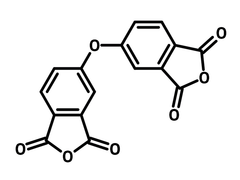4,4'-Oxydiphthalic anhydride (ODPA)
CAS Number 1823-59-2
Chemistry Building Blocks, COF Ligands, Diamines and Dianhydrides, Heterocyclic Building Blocks, Materials, Monomers,A dianhydride building block with a phenyl ether moiety
An intermediate for polyimides synthesis in application of super capacitors, battery anodes, fluorescence emitters and MOFs-based memory devices
Specifications | MSDS | Literature and Reviews
4,4'-Oxydiphthalic anhydride (ODPA, CAS number 1823-59-2), end-capped with two carboxylic anhydrides, is typically used for polyimide synthesis in material science. The polyimide films from 4,4'-oxydiphthalic anhydride exhibit high thermal resistance and high specific capacitance (121 F/g). They work well as separators in supercapacitors. The polyimides are also used as anodes in Li-batteries, owing to their dissolution in the electrolyte to maintain the electrochemical performance of Li-batteries.
ODPA can be hydrolysed and chelated to metal ions (e.g., indium) forming metal organic frameworks (MOFs) for multilevel flexible optoelectronic memory devices. The memory devices have over 192 distinct levels (6-bit storage) and stable retention (10000 s).
General Information
| CAS Number | 1823-59-2 |
| Chemical Formula | C16H6O7 |
| Full Name | 4,4′-Oxydiphthalic anhydride |
| Molecular Weight | 310.21 g/mol |
| Synonyms | 3,3′,4,4′-Diphenyl ether tetracarboxylic acid dianhydride, Bis-(3-phthalyl anhydride) ether, 5,5′-Oxybis(1,3-isobenzofurandione) |
| Classification / Family | Dianhydride building blocks, Phenyl ether derivatives, MOFs, Batteries, Capacitors, Fluorescence emitters |
Chemical Structure

Product Details
| Purity | >99% |
| Melting Point | Tm = 225 °C – 229 °C |
| Appearance | White to off-white powder |
MSDS Documentation
 4,4'-Oxydiphthalic anhydride (ODPA) MSDS Sheet
4,4'-Oxydiphthalic anhydride (ODPA) MSDS Sheet
Literature and Reviews
-
Long-living luminescence emitted from imide compounds dispersed in polymer matrices after continuous ultraviolet irradiation and its relation to oxygen quenching, M. Doi et al., ChemPhotoChem, e202200310(2023); DOI: 10.1002/cptc.202200310.
-
Dielectric polymers for high-temperature capacitive energy storage, H. Li et al., Chem. Soc. Rev., 50, 6369-6400(2021); DOI: 10.1039/D0CS00765J.
-
Electrospun benzimidazole-based polyimide membrane for supercapacitor applications, Y.-H. Lu et al., Membranes, 12, 961(2022); DOI: 10.3390/membranes12100961.
